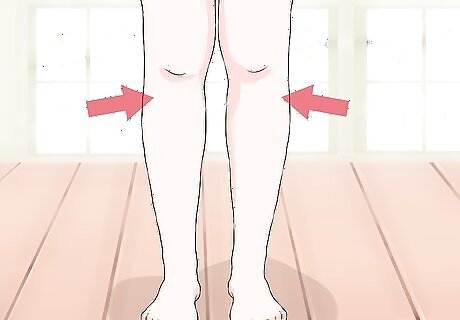
views
Setting Up a Measurement

Find a wall to use for measuring. You are looking for a wall that has unobstructed access. It should be solid without a window or other cut-outs. It needs to be wide enough to fully fit the person’s shoulders without them touching anything else. The floor in the area should be level as well. It is even better if you can find a wall that faces a mirror. This will allow you to track your movements during the process, which usually results in a more accurate final number.

Remove all bodily obstructions. The person whose height is being measured should take off their shoes. Place them to the side and stay barefooted (or wear socks) for the duration of the measuring process. Take down any hair accessories that could interfere with measuring process, such as a ponytail. If the person is wearing a bulky coat or jacket, have them take it off. One of the reasons that bulky clothing must be removed is so that you can observe body posture and make sure that the person is standing up perfectly straight when measured.

Stand up straight. Move to the wall for measuring. Place the person to place their back against the wall. Ask them to hold themselves up nice and straight for the entire time. When you look at their profile from the side, you should verify that the backs of their feet, head, shoulders, and bottom all lightly touch the wall.

Position their legs together. Ask the person to pull their legs slightly close to one another. Their weight should be balanced between both feet. Their knees and ankles should be close to touching or actually touching one another. For some people with knee conditions this may be an uncomfortable position. Check with the person to make sure that they are not experiencing any pain.

Place their hands and arms to the side of their body. Your subject may want to clasp their hands before them or cross their arms, however, this will have an effect on their posture and final height measurement. Instead, ask them to purposefully hang their arms loosely at their side. If you are measuring a child, you might tell them to keep their body as straight as a board and their arms as limp as noodles.

Ask them to look forward. Point out a spot across the room, at eye level height, and request that they focus on this area while you complete the measurement. Circle around the person and make sure that their eyes and ears are horizontal to one another in profile. This is called the “Frankfort Plane” alignment and indicates that their head is in the correct position. To correctly observe the Frankfort Plane, you will need to be as tall, or taller, than the person being measured. So, have a step-stool nearby to assist you, if needed. If you are measuring a child, watch to see if they move their head around after taking a breath. If this is the case, you will want to re-position their head and then take a quick measurement.
Measuring a Person’s Height Manually

Use the pencil mark method. Place a pencil in a horizontal position above the person’s head with the tip facing the wall. Lower the pencil until it reaches the top of their head, maintaining the level position. Slowly move the pencil tip toward the wall until it makes a mark. Get out a flexible tape measure. Place the tape against the wall and measure up from the floor to your mark. You can use any marking device, however, a pencil is best as you can erase the marks when you are finished. Just make sure to make a dark enough mark so that it is visible when you pull away. Make sure that you keep the tape straight as you go up from the wall. It should also lay lightly against the wall. You can use a straight ruler instead if you so choose, making a wall mark every 12 inches and then adding it all up. If you are measuring yourself you can do this method too, just make sure to keep the pencil level. It also helps if you are using a wall opposite a mirror so you can track your movements.

Use a stadiometer. This is a piece of medical equipment composed of a measuring board affixed to the wall with a drop-down (adjustable) rod at the top. Have the person stand against the board and then adjust the rod so that it rests on the top of the person’s head. With a manual stadiometer, you will need to write down the height where the rod meets the board. With a digital stadiometer, the height will be displayed immediately after you adjust the rod. It is not necessary to push the measuring rod down upon the person’s head. It is enough to lightly touch the head with the rod.

Measure on a horizontal surface. To get an accurate number you will need to have the person lay down on a firm area. You can use an examination table in a doctor’s office for a small child. Or, a firm bed if you are measuring an immobile adult. Ask the person to look toward the ceiling. Lightly press their knees together and down until they contact the flat surface. Use a measuring tape to measure from the base of their feet to the top of their head. Be aware that this method is less accurate when used with taller persons. So, try to use a stand-up wall method whenever possible. This is often a good option for children who are moving around a great deal, but who are too big for the infant measuring device and too wiggly to stand up against the stadiometer. You can also make a pen or marker mark at the base of their feet and at the top of their head and measure between the marks. This works well if you don’t mind marking up a bedsheet or if you are measuring on a paper surface (like at a pediatrician’s office).

Use a specialized horizontal headboard and footboard device. This is the preferred way to measure infants. You will lay the infant down in a measuring area. You then pull the headboard and footboard toward the baby until they meet its head and feet, respectively. You measure from board-to-board to determine height. Some of the more advanced measuring devices found in pediatricians’ offices will actually show a digital display of the final measurement or distance between the boards.

Record the final measurement. If possible, it is always easier to have one person doing the measuring while another person writes down the resulting numbers. However, if you are doing everything on your own, just make sure to write down the numbers as soon as you have them to preserve accuracy. Record all of your measurements to the nearest 1/8th of an inch (0.1cm). It is a good idea to take all measurements twice, if possible. Compare the two results to see if they are close enough to one another to indicate accuracy. If they are more than 1/8 of an inch apart, then you may want to measure one more time.
Measuring an Object’s Height Using Technology

Purchase and download a measurement app. Go to the app store and search for a “measure app.” You will see a number of options pop up, including the Easy Measure app. Read through the reviews and look over the pricing before you buy. Choose the one that best suits your needs and download it. For example, Easy Measure has a variety of attractive features. It comes with an animated tutorial explaining how to tackle measuring challenges. It also allows you to take a photo of the object measured and store it alongside the measurement for easy reference.

Open the app. When you are ready to measure an object, you’ll need to get within eyesight of it and take out your phone. Start up the application and complete any requested calibrations. Try out a few different ways to hold your phone in order to keep it the most stable.

Point your camera at the object. Place your camera at eye level and direct it toward the object in question. Make sure that you pull your fingers out of the way as well. Move forward or backward to get the entire object into the view frame. This may take a bit of practice, so give yourself ample time. Part of the calibration process involves setting the correct camera height. It is best if you subtract 4 inches from your height and use that number (just so long as you keep the camera at eye level).

Take a clear picture of the object. Snap a few photos of the object and wait for the measuring magic to take place. The app will display the height of the object and you’ll have the option to save this information for later or even share it on social media. If you doubt the accuracy of the final measurement, do a few test runs on objects close to you. Use the camera to measure these objects and then take a traditional tape measurement as well. Compare the two numbers and they should line up to 1/8th of an inch.




















Comments
0 comment